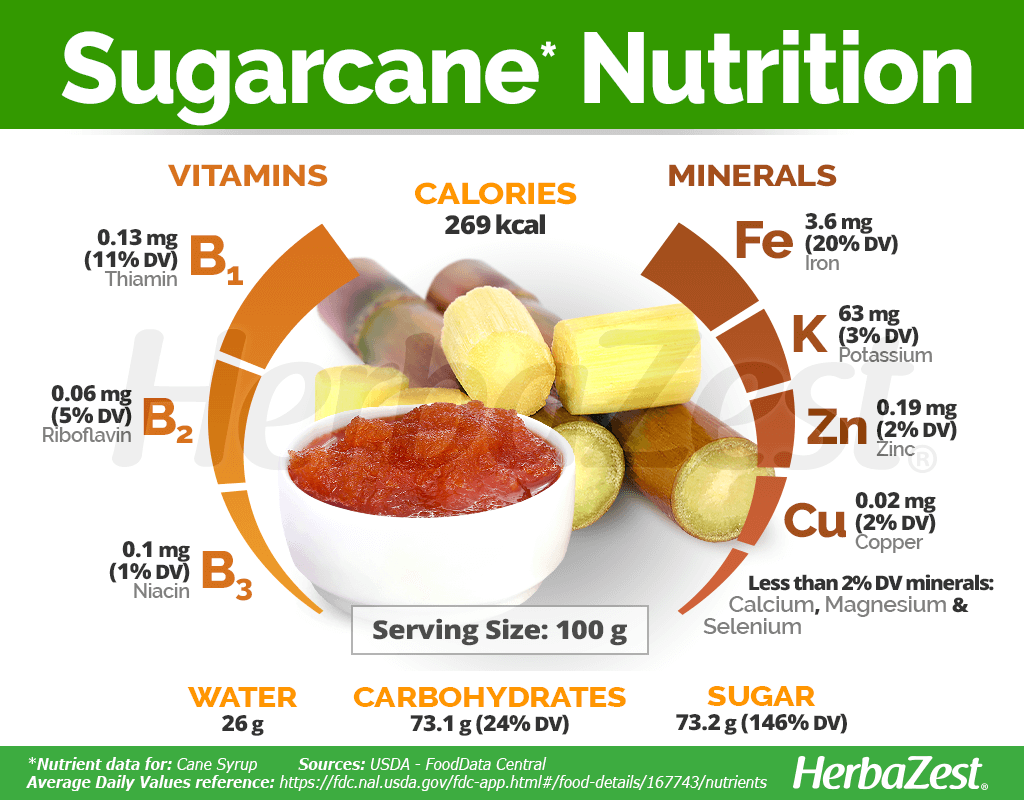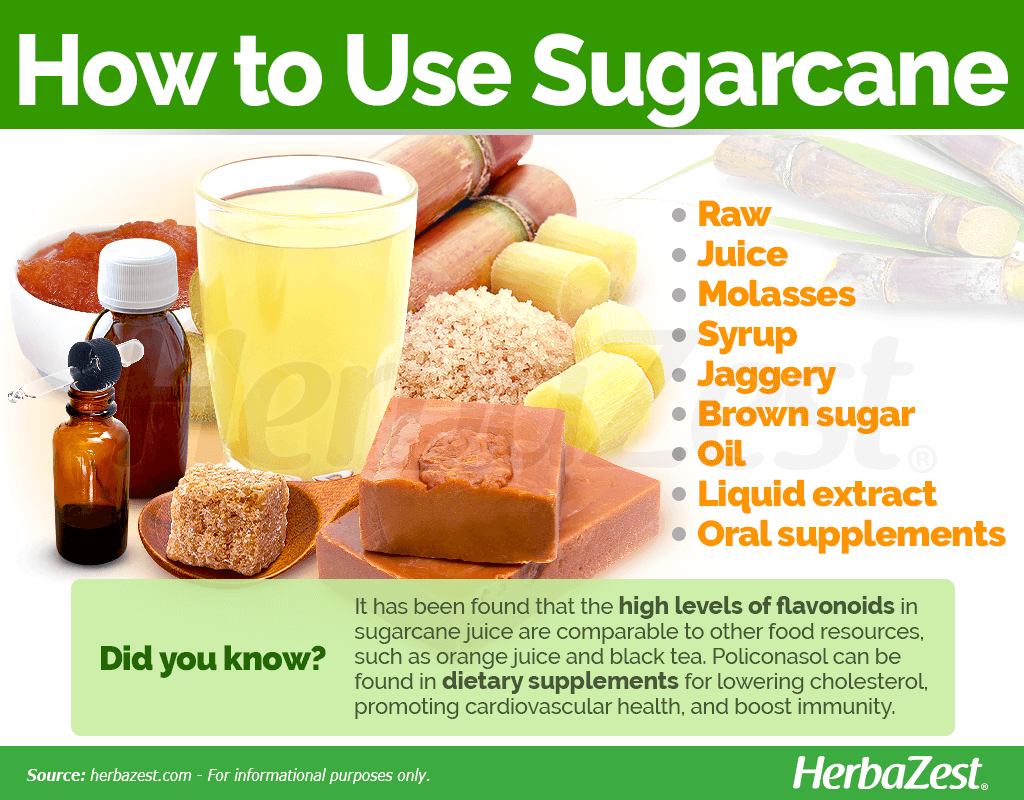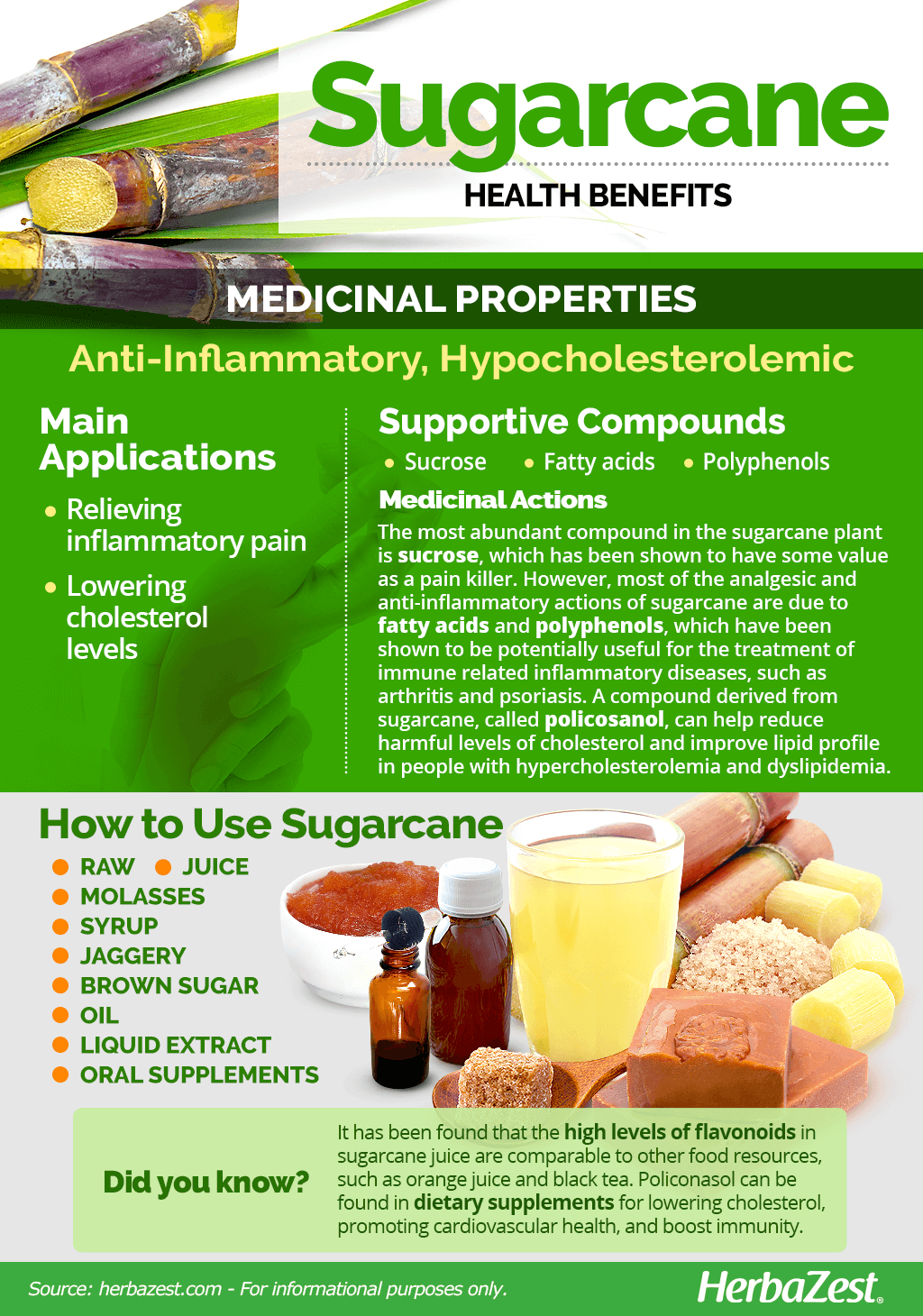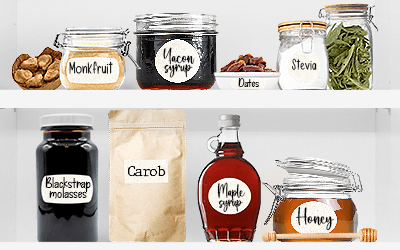A tall grass, native to tropical South and Southeast Asia, sugarcane is nowadays cultivated across the globe due to its great economical value and medicinal properties. Many products are obtained from the sugarcane plant and it has multiple applications beyond satisfying a sweet tooth.
Sugarcane Medicinal Properties
Health Benefits of Sugarcane
Sugarcane is currently an essential source for sweetener manufacturing; however, it has been historically consumed with nutritional and medicinal purposes. A number of sugarcane benefits can be obtained from unrefined forms, mainly:
Relieving inflammation. Sugarcane essential compounds have shown anti-inflammatory and analgesic properties, helping with autoimmune diseases such as arthritis and psoriasis.
Lowering cholesterol levels. Some byproducts of sugarcane can hinder harmful cholesterol (LDL) build up, thus reducing the risk of vascular problems, such as atherosclerosis.
The constituents of sugarcane are also thought to be useful for stabilizing blood sugar levels and promoting liver and kidneys health.
In ancient medicinal systems, such as Ayurveda and Unani, sugarcane properties have been traditionally used to treat diverse health issues, from jaundice and constipation to fluid retention and infected wounds.
How It Works
While sucrose, a type of glycoside, is the most abundant compound in the sugarcane plant, and it's been shown to have some medicinal value as natural mild pain killer1, most of sugarcane properties are derived from polyphenols, fatty acids, phytosterols, and terpenoids.
The analgesic and anti-inflammatory actions of sugarcane are due to the inhibitory action of fatty acids on the metabolism of arachidonic acid, which is key for the synthesis of two inflammatory mediators: prostaglandins and leukotrienes. These properties have been shown to be potentially useful for the treatment of immune related inflammatory diseases, such as arthritis and psoriasis.2,3
A clinical study concluded that a mixture of purified primary alcohols from sugarcane, called policosanol, can help reduce harmful levels of cholesterol and improve lipid profile in people with hypercholesterolemia and dyslipidemia.4
On the other hand, the antioxidant properties of polyphenols are partly responsible for the anti-inflammatory benefits of sugarcane.5
IT HAS BEEN FOUND THAT THE HIGH LEVELS OF FLAVONOIDS IN SUGARCANE JUICE ARE COMPARABLE TO OTHER FOOD RESOURCES, SUCH AS ORANGE JUICE AND BLACK TEA.6
Other herbs with anti-inflammatory properties are turmeric and ginger, whereas avocado and oat are also known for keeping in check cholesterol and blood sugar levels.
Sugarcane Cautions & Side Effects
Unlike table sugar, unprocessed sugarcane forms are considered generally safe in moderation. A popular nutraceutical compound derived from sugarcane, policonasol, is popularly used in medicinal amounts to reduce low-density lipoproteins (LDL), or bad cholesterol, and it has also shown anticoagulant actions;7 however, it can cause mild side effects, such as weight loss, headaches, dizziness, stomach aches, and insomnia.
Additionally, while sucrose medicinal administration has been shown to have some analgesic benefits, the consequences of sucrose overconsumption have been well documented: it can lead to fatty liver and increases the risk of diabetes 2.
- Medicinal action Anti-inflammatory, Hypocholesterolemic
- Key constituents Sucrose, fatty acids, polyphenols
- Ways to use Liquid extracts, Food, Juiced, Syrup, Essential oil
- Medicinal rating (2) Minorly useful plant
- Safety ranking Safe

Sugarcane Nutrition
Sugarcane is not only the primary source of a myriad of sweet products, but also provides a good deal of nutrients. In spite of its high contribution of sucrose (around 88-99%, depending on the variety), sugarcane unrefined forms provide essential minerals, mainly iron, necessary for red blood cells production and useful for treating anemia; some B-Group vitamins, mainly B1 (thiamin) and B2 (rivoflavin), both of which help with the metabolism of fats, transforming food into energy.
In less processed forms, sugarcane also provides small amounts of many essential nutrients, such as potassium, zinc, and copper.
100 GRAMS OF CANE SYRUP PROVIDE 269 CALORIES, WHICH ARE MAINLY COMPOSED BY CARBOHYDRATES (24%)

How to Consume Sugarcane
Natural forms
Raw. Sugarcane stalks are refreshing and popularly chewed to extract their sweetness and beneficial properties.
Juice. Sugarcane juice, freshly extracted, is a great source of antioxidants, including vitamin C and flavonoids. It can help boost inmmunity, liver function, and glucose metabolism.8
UNLIKE EXTREMELY PROCESSED SUGARCANE PRODUCTS, SUCH AS TABLE SUGAR, UNREFINED FORMS PROVIDE A HIGH ANTIOXIDANT CONTENT, ALONG WITH ESSENTIALNUTRIENTS.
Herbal Remedies & Supplements
Molasses. Molasses are a thick, brown substance that results as a byproduct of sugar refining process. Molasses are not only iron-rich, but also have compounds that enhance the absorption of this essential mineral, necessary for treating and preventing iron deficiency anemia.
Syrup. Cane syrup is just boiled fresh cane juice. It is lighter than molasses, with a texture similar to that of maple syrup, but a darker hue and deeper flavor, and can be used over pancakes and waffles.
Jaggery. Made from concentrated sugarcane juice, jaggery is natural sweetener, commercialized either in solid form, as a block, or grated. It is dark-brown and exceptionally rich in minerals, proteins, and vitamins, notably including B complex vitamins, calcium, and iron.
Oil. The oil extracted from sugarcane not only has antibacterial properties, but also provides important nutrients, mainly vitamin A,C, and E. Sugarcane oil extract is commonly used topically, in order to moisturize and rejuvenate the skin, reducing the visible signs of aging, such as wrinkles and dark spots.
Brown sugar. Mainly used as a natural sweetener, brown sugar is less processed and its glycemic index is lower that white sugar, or table sugar. It retains important amounts of antioxidants as well as iron and calcium, all of which help boost immunity and prevent anemia.
Liquid extract. Sugarcane extract is water-soluble preparation, commonly mixed with glycerine and water, and popularly used for skin care, due to its moisturizing, soothing properties.
Oral supplements. An important compound derived from sugarcane, policonasol, can be found in pills, as a dietary supplement for lowering cholesterol, promoting cardiovascular health, and boost immunity. Sugarcane extract is also available in capsules and touted as an excellent source of antioxidants
- Edible parts Stem
- Edible uses Beverage, Sweetener
- Taste Sweet

Growing
The sugarcane plant is a perennial species that grows back after harvest. After five or six "regrowths", the old plants are pulled up and new cuttings are sown. Sugarcane plantations cover great extensions of land in tropical an subtropical regions. However, due the right conditions of soil depth, temperature, and humidity, sugarcane can be cultivated at a smaller scale.
Growing Guidelines
The sugarcane plant can be grown from seeds, but it is generally reproduced by cuttings, which optimal rate of germination occurs at temperatures between 89.6 and 100.4°F (32-38°C), while the best temperature for sugarcane growth is within the range of 71.6-86°F (22 and 30°C).
Sugarcane does not require a special type of soil; however, it is moderately sensitive to salinity, which decreases crop's yield. Best soils are those well-drained, with more than 3.28 feet (1 m) deep but deep rooting to a depth of up to 16.4 feet (5 m) is possible.
Row spacing varies usually between 3.6 and 4.6 feet (1.1-1.4 m); number of sets per ha depends on the number of buds per set.
Sugarcane germination starts within 7-10 days, and the new shoots can be planted after 30-35 days. Once the sugar cane is established, it will grow for 9-16 months (or 18-24 months in cooler climates).
Depending on climate conditions, sugarcane water requirements are 59-98 inches (1500-2500 mm), evenly distributed over the growing season.
When it comes to fertilization, the sugarcane plant has a great demand of nitrogen and potassium, with lower phosphate requirements.
Depending on the variety, the sugarcane plant can be affected by fungal, bacterial, and viral diseases.
- Life cycle Perennial
- Harvested parts Stem
- Light requirements Full sun
- Soil Well-drained
- Growing habitat Subtropical regions, Tropical regions, Warm climates
- Propagation techniques Cuttings
Additional Information
Plant Biology
Sugarcane, less known as plumegrass, is a tall grass that grows in tropical and subtropical regions around the world. Sugarcane roots support several, unbranched stems, or stalks, that are straight and composed by segments called joints, each one with alternated nodes. Sugarcane stalks can reach 6.6-9.8 feet (2-8 m) in height, with only 0.78-3.15 inches (2-8 cm) in width, and can range in color, depending on the variety, from green and yellowish-green to purple and a mixture of bright, multiple colors. Sugarcane stalks are covered by a waxy substance that is often visually unnoticeable, but sometimes can look like a thick, dark hue. The sugarcane leaves start as sheaths wrapped around the stalk, growing into green, narrow blades, 2 inches (5 cm) wide and up to 5 feet (150 cm) long, with a thick midrib, rough, sharp edges, and pointed tips.
Classification
Sugarcane (Saccharum officinarum) is a member of the Poaceae family, which includes over 10,000 species across 750 genera, and it is known to contain "true grasses," many of them valuable crops like barley (Hordeum vulgare), lemongrass (Cymbopogon citratus), maize (Zea mays), millet (Pennisetum glaucum), rice (Oryza sativa), oat (Avena sativa), and wheat (Triticum aestivum).
Varieties and Cultivars
All sugarcane varieties are hybrids evolved from the different species compressed by the genus Saccharum: S. officinarum, S. spontaneum, S. rubustum, S. barberi, S. sinense, and S. giganteum; all of which contribute with one or more characteristics to sugarcane modern varieties. After thousands of years of cultivation, there are countless sugarcane varieties, with different levels of sucrose content, disease resistance, drought tolerance, and time of maturity.
The most popular varieties of sugarcane are derived from Saccharum officinarum, and are called Noble Cane varieties.
Historical information
The first remains of sugarcane cultivation have been discovered in India, dating back to the Bronze Age, when the Indus Valley Civilization flourished, about 5,000 years ago, while written records of sucarcane processing are about 2,000 years old. When Persians entered that part of Asia, around 510 BCE, under Darius the Great, they reported seen fields filled with tall grasses able to "produce honey without bees".
In 326 BCE, Alexander the Great saw crystalized sugar for the first time; however, Arabs were the the first to transport and commercialize sugar across Egypt, Syria, Cyprus, Crete, and Spain during the 6th century.
By the Middle Ages, sugarcane was widely cultivated in southern Europe, and it became one of the most valuable commercial crops by the end of the 1500's, with large plantations across tropical areas of the New World, including modern day Brazil, Cuba, Jamaica, Puerto Rico and other Caribbean islands.
Economic Data
Nowadays, sugarcane is cultivated in countries between 35° North and South of the equator, where climate conditions are suitable. With over 13 million ha cultivated, the global production of sugarcane reaches about 1254.8 million tons per year, which translates into 55 million tons of sucrose annually.
Brazil is the world's largest sugar producer, closely followed by India.
Other Uses
Fodder. Molasses are used to supplement the diet of farm animals. Bagasse is also fed to cattle, although it is hard to digest and lacks dietary value.
Biofuel. Sugarcane is also used to produce ethanol, an alternative and renewable source of energy.
Alcohol. In the areas where this tall grass is cultivated, sugarcane's ethanol is popularly used to make alcoholic beverages.
Industry. Sugarcane bagasse is used as raw material in the production of many industrial products, such as paper, compostable plates and cutlery, construction panels for thermal insulation, and textiles.
Food industry. Sugarcane is one of the sources used to produce MSG (monosodium glutamate), a flavor enhancer popularly used in all kind of food products.
- Other uses Alcohol, Animal feed, Textiles, Paper, Fuel
Sources
- Complementary and Alternative Therapies and the Aging Population, Policosanol to Manage Dyslipidemia in Older Adults, 2009
- Critical Reviews in Food Science and Nutrition, The Effects of Sucrose on Metabolic Health: A Systematic Review of Human Intervention Studies in Healthy Adults, 2013
- Food and Agriculture Organization (FAO), Sugarcane
- Food Science & Nutrition, Antioxidant activity, nutritional and physicochemical characteristics, and toxicity of minimally refined brown sugar and other sugars, 2020
- Frontiers in Bioengineering and Biotechnology, Potential for Genetic Improvement of Sugarcane as a Source of Biomass for Biofuels, 2015
- Genetic Resources and Crop Evolution, A short review on sugarcane: its domestication, molecular manipulations and future perspectives, 2023
- Journal of Dietary Supplements, Sugarcane Molasses - A Potential Dietary Supplement in the Management of Iron Deficiency Anemia, 2017
- Non-Alcoholic Beverages, Volume 6: The Science of Beverages - Physiochemical Characteristics Nutritional Properties and Health Benefits of Sugarcane Juice, 2019
- Reinventing the Cuban Sugar Agroindustry, p. 209
- Sugar Nutrition Resource Centre, Growing sugar cane, 2021
- University of California, Davis, Both Sucrose and High Fructose Corn Syrup Linked to Increased Health Risks, 2021
- University of Florida, IFAS Extension - Sugarcane Botany: A Brief View
- University of Hawaii, College of Tropical Agriculture and Human Resources - General Cane Information
- Pharmacognosy Reviews, Phytochemical profile of sugarcane and its potential health aspects, 2015
Footnotes:
- Brazilian Journal of Medical and Biological Research. (2014). Examining the side effects of sucrose for pain relief in preterm infants: a case-control study. Retrieved January 23, 2023, from: https://www.ncbi.nlm.nih.gov/pmc/articles/PMC4086181/
- Planta Medica. (2003). Anti-inflammatory and analgesic effects of a mixture of fatty acids isolated and purified from sugar cane wax oil. Retrieved January 11, 2023, from: https://pubmed.ncbi.nlm.nih.gov/12709906/
- Phytomedicine. (2007). Effects of a mixture of fatty acids from sugar cane (Saccharum officinarum L.) wax oil in two models of inflammation: zymosan-induced arthritis and mice tail test of psoriasis. Retrieved January 11, 2023, from: https://pubmed.ncbi.nlm.nih.gov/17292594/
- Phytotherapy Research. (2008). Effect of sugar cane policosanol on lipid profile in primary hypercholesterolemia. Retrieved January 11, 2023, from: https://pubmed.ncbi.nlm.nih.gov/18167048/
- Foods. (2022). Sugarcane Straw Polyphenols as Potential Food and Nutraceutical Ingredient. Retrieved January 11, 2023, from: https://www.ncbi.nlm.nih.gov/pmc/articles/PMC9777897/
- Heliyon. (2023). Bioactive compounds as an alternative for the sugarcane industry: Towards an integrative approach. Retrieved January 11, 2023, from: https://www.ncbi.nlm.nih.gov/pmc/articles/PMC9932480/
- Integrative Medicine (Second Edition). (2007). Peripheral Vascular Disease. Retrieved January 22, 2024, from: https://www.sciencedirect.com/science/article/abs/pii/B9781416029540500338
- Journal of The American College of Nutrition. (2019). Antioxidant and Anti-Diabetic Functions of a Polyphenol-Rich Sugarcane Extract. Retrieved January 26, 2024, from: https://pubmed.ncbi.nlm.nih.gov/31008696/






